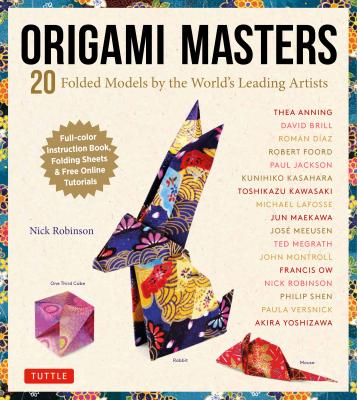ТОП просматриваемых книг сайта:
Origami Masters Ebook. Nick Robinson
Читать онлайн.Название Origami Masters Ebook
Год выпуска 0
isbn 9781462922055
Автор произведения Nick Robinson
Жанр Сделай Сам
Издательство Ingram
NOTES ABOUT ORIGAMI PAPER
The paper supplied with this kit has been specially selected and prepared to enable you to produce amazing origami models. But sooner or later, this supply of beautiful sheets will become exhausted, and you will need to look elsewhere for folding paper. There are lots of options for “proper” origami paper (which can be bought cheaply on the Internet, and in craft stores), but you can also choose from many other types of paper, particularly if you want to fold a large version of a model. The paper should be crisp and capable of “remembering” a crease (so it doesn’t begin to unfold on its own). Craft and art shops have a wide range of beautiful papers, so try to choose a pattern that really suits the final design. It will be a better value to buy a large sheet, and then cut it down to make several smaller squares. The steps below show a simple method for cutting a rectangular sheet into a perfect square.
1 Fold a short edge to a long edge.
2 Fold the surplus paper over the edge, crease and unfold.
3 Unfold the paper fully.
4 Cut off the surplus paper along the crease to leave a square.
A GUIDE TO ORIGAMI FOLDING SYMBOLS
Valley fold
Fold the paper in the usual way.
Valley fold and unfold
Make a crease, and then unfold it.
Mountain fold
Fold a flap or layer behind. This can usually be made as a valley fold by turning the paper over.
Turn over
Lift the paper up and turn it upside down, like flipping a pancake.
Repeat arrow
Whatever move you have made is repeated elsewhere on the paper. The arrow may give you specific steps to repeat and / or show how many times to repeat the step.
Rotate 180 degrees
Turn the paper so the lowest edge becomes the uppermost edge.
Rotate 90 degrees
Turn the paper a quarter turn in the direction indicated by the arrow.
Fold to dotted line
A dotted line denotes an imaginary crease or edge as guidance for a fold.
Pleat
This is a combination of valley and mountain folds, which are made at the same time.
Pull out
The wide open arrows indicate where flaps of layers should be restored to a previous position.
Outside reverse fold
The paper is wrapped around the outside. This fold is usually precreased before folding.
Inside reverse fold
The paper is pushed inside existing layers. This fold is usually precreased before folding.
Crimp
A black triangle indicates that you will be applying pressure to the paper somewhere. Here, the symbol is used to indicate a crimp, which is a 3-D pleat.
Fold equal distances
This is usually a general guide, rather than one that requires accuracy.
Squash fold
A black triangle indicates you will be applying pressure to the paper somewhere. Here the symbol is used to indicate a squash fold, where a pocket is opened, and then pressed flat.
TWO-FOLD SANTA
By Paula Versnick
Two folds are all you need to make this superb example of minimalist origami.
1 With the side that you wish to become Santa’s cap and coat facing down, fold the lower left corner to touch the center of the upper edge. The final shape of Santa is determined by this fold, but it isn’t critical!
2 The result. Turn the paper over.
3 Rotate the paper.
4 Fold so the circled points meet.

